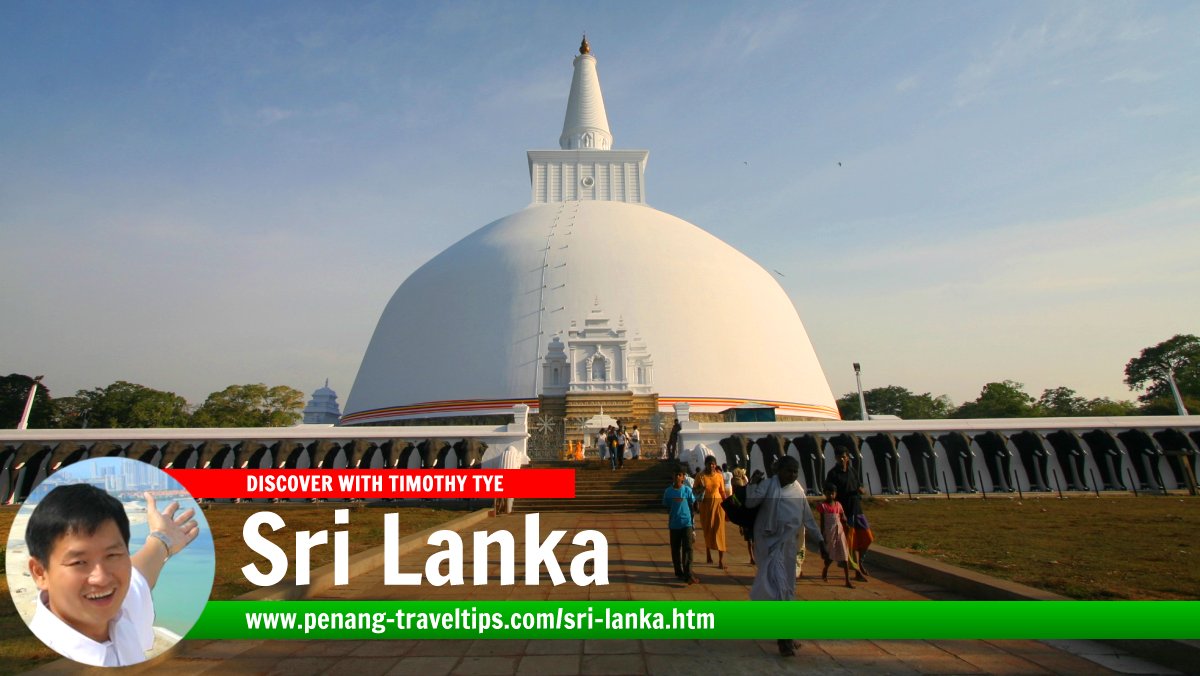 Sri Lanka (28 August, 2005)
Sri Lanka (28 August, 2005)
Sri Lanka (Sinhala: ශ්රී ලංකාව; Tamil: இலங்கை) is a country located almost at the southernmost tip of the Indian subcontinent. Dangling like an emerald pendant, it is a dazzlingly beautiful country blessed with an ancient history that stretches for over two thousand years. This endows Sri Lanka with a multitude of ancient ruins, many of which today receive recognition from Unesco as World Heritage Sites.
As I explored the ancient Sri Lankan cities, I cannot help being amazed at the engineering feats of the Sri Lankan people a thousand years ago. From the low, arid country, we proceed to the highlands, to the tea country. At Nuwara Eliya, we enjoyed the lovely scenery and cool climate. We also had the good fortune of staying at the Tea Factory, a 5-star hotel that was once a tea processing plant, and which won a Unesco award for heritage conservation.
Travel Tips of Major Tourist Cities in Sri Lanka
- Colombo (capital)
- Anuradhapura - Most famous ancient city.
- Kandy - Last major kingdom of Sri Lanka.
- Polonnaruwa - Second ancient capital of Sri Lanka.
- Sigiriya - Site of ancient palace complex.
Major Destinations in Sri Lanka
- Aukana Buddha
- Dambulla Cave Temple
- Galle Fort
- Mihintale - Sacred site where Buddhism was first introduced into Sri Lanka.
- Negombo
- Nuwara Eliya - Major tea plantation highlands.
- Peradeniya Botanical Gardens
- Pinnawela Elephant Orphanage
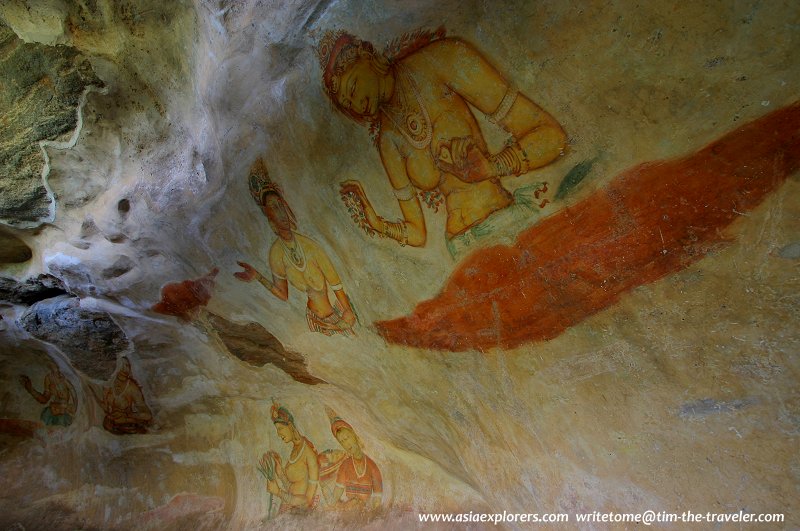 Ancient murals of Sigiriya (29 August, 2005)
Ancient murals of Sigiriya (29 August, 2005)
From the highlands, we proceeded southwards, to the southernmost major city of Sri Lanka, Galle, where we visited another World Heritage Site, Galle Fort. Along the way, we stopped over to look at the devastation caused by the tsunami of December 2004.
In any write-ups about Sri Lanka, it would be glaring not to mention the internal conflict that plagues the nation. It is an issue that concerns most people as they contemplate a trip there - is it worth the risk? From my experience with Sri Lanka, although the internal conflict between the primarily Sinhalese government and the Liberation Tigers of Tamil Eelam often dents Sri Lanka's image as a tourist destination, in actual fact, most of the tourist destinations are free from attacks. And quite safe too.
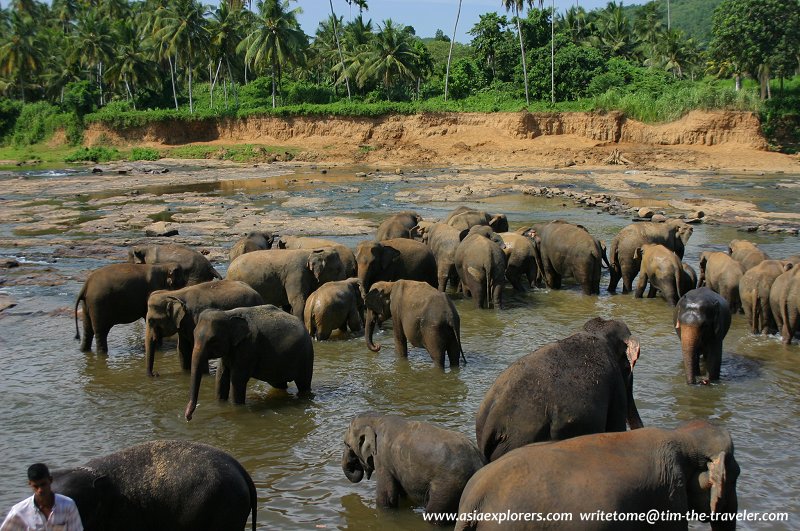 Pinnawala Elephant Orphanage (28 August, 2005)
Pinnawala Elephant Orphanage (28 August, 2005)
Having said that, I have to caution you to be prepared for tight security in Sri Lanka, especially in Colombo. In the downtown area of Fort, for example, I was forbidden from taking photographs. I saw soldiers all over the Fort district. This is due to the military installation nearby. Therefore, one of Colombo's most prominent landmarks, the lighthouse Clock Tower, is out of bounds for photography. Also, I learned that many of the major hotels have been bombed before, including the one where we were staying during out Sri Lankan trip, the 5-star Galadari Hotel.
Fortunately, the rest of Sri Lanka, outside of the troubled north, is still very safe and open. Not only that, the people are generally friendly and gracious, and makes every visitor feel welcome. On this website, I want to show you most of the major tourist sites, including the ancient cities, highland getaways, Sri Lankan culture and forts.
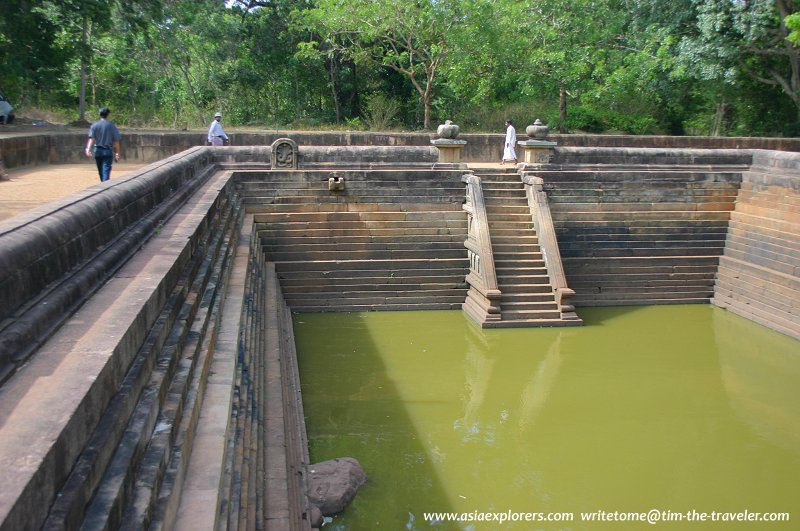 View inside a pond at Kuttam Pokuna (29 August, 2005)
View inside a pond at Kuttam Pokuna (29 August, 2005)
Sri Lanka Travel Information
- Official Name: Democratic Socialist Republic of Sri Lanka
- Capital: Colombo (710,000, metropolitan area: 2,500,000)
- Population of the Sri Lanka: 20,064,800; 74% Sinhalese, 18& Tamil, 7% Muslim of Arab and Indian Muslim descent
- Religions: Buddhist (70%), Islam (26%), Hindu, others
- Languages: Sinhala, Tamil, others
- Currency: Sri Lankan Rupee
- Time Zone: 6 hours ahead of Greenwich Mean Time.
- International Dialing Code: 94
- Electricity: 230-240V 50Hz; Most outlets use the three-pronged sockets. If travelling with a laptop, bring along a stabiliser in addition to adaptor, as power often fluctuates. (See details here: http://www.kropla.com/electric.htm)
- Driving: On the left side of the road.
- Size: 65,610 sq km (25,332 sq miles)
- Region: Asia
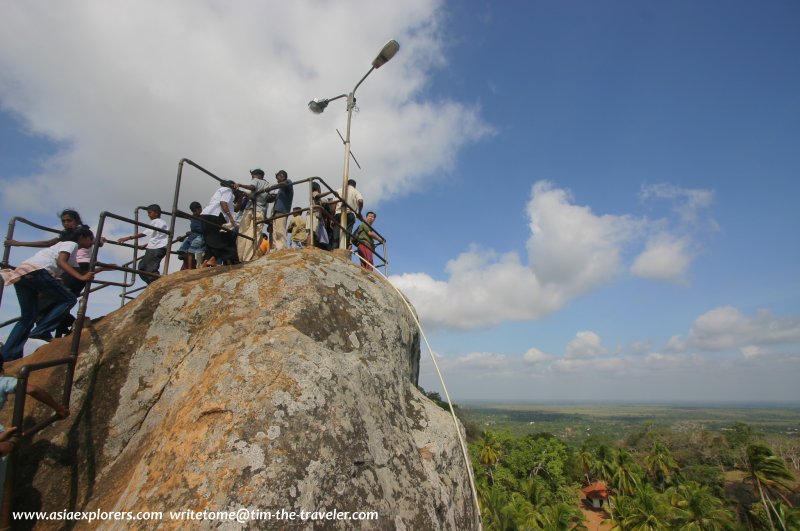 Mihintale viewpoint (30 August 2005)
Mihintale viewpoint (30 August 2005)
Cities and Sights on the West Coast of Sri Lanka
- Akurela Beach
- Aluthgama
- Ambagahapityia Welitara
- Ambalangoda
- Balapitiya
- Bentota
- Beruwala
- Brief
- Chilaw
- Dodunduwa
- Galagoda Temple
- Galapata Vihara
- Gangatilaka Vihara
- Hikkaduwa
- Induruwa
- Kachimalai Mosque
- Kalutara
- Kosgoda
- Madampe
- Mahawewa
- Marawila
- Moratuwa
- Munnesvaram
- Narigama
- Negombo
- Panadura
- Panduvasnuwara
- Puttalam
- Richmond Castle
- Sinharaja Rainforest
- Sri Janandarama Mahavihara
- Sri Pushparama Vihara
- Sunandaramaya Mahavihara
- Udappuwa
- Wewela
- Wilpattu National Park
- Bundala Bird Sanctuary
- Count de Maunay's Island
- Dikwella
- Dondra
- Galle
- Galle Cultural Museum
- Groote Kerk
- Hambantota
- Hoo-aaniya Blowhole
- Kataluwa Temple
- Kataragama
- Koggala
- Koggala Lake
- Kottuwa Rainforest
- Maha Vishnu Devala
- Martin Wickramasinghe Folk Art Museum
- Matara
- Matara Fort
- Mulgirigalla
- Museum of Ancient Paintings
- National Maritime Museum
- Polhena
- Tangalla Bay
- Tissamaharama
- Uda Walawe National Park
- Unawatuna Bay
- Weligama
- Wewurukannala Vihara
- Yala National Park
- Aluvihara
- Buduruvalagala
- Dambadeniya
- Dimbulaga
- Gadaladeniya
- Habarana
- Kurunegala
- Lankatilaku
- Mahiyangana
- Medirigiriya
- Nalanda Gedige
- Panduvasnuwara
- Ridigama
- Sasseruwa
- Somawathie Dagoba
- Yapahuwa
- Arugam Bay
- Batticaloa
- Bundala
- Fort Frederick
- Kalkudah Bay
- Kanniyai
- Koddiyar Bay
- Kokkilai
- Mutur
- Nilaveli
- Passekudah Bay
- Pigeon Island
- Seruwawila
- Swami Rock
- Toppur
- Trincomalee
- Uppuveli
Cities and Sights of the South Coast of Sri Lanka
Cities and Sights of the Cultural Heart of Sri Lanka
Cities and Sights on the East Coast of Sri Lanka
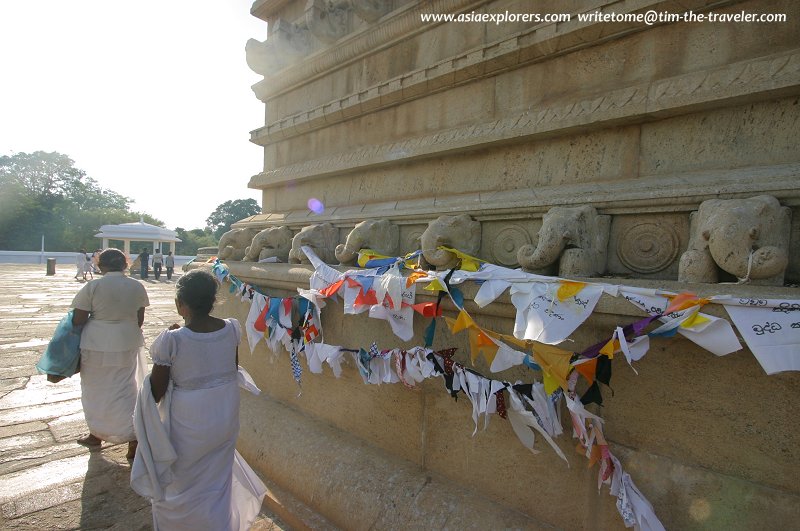 Pilgrims encircling the Ruwanweliseya Dagoba (29 August, 2005)
Pilgrims encircling the Ruwanweliseya Dagoba (29 August, 2005)
How to enter Sri Lanka
The Colombo Bandaranaike International Airport (CMB) located north of Colombo is the main gateway into Sri Lanka. It is the base for national flag carrier Sri Lankan Airlines. Upon arriving at the airport, you can catch a taxi or a three-wheeler to the city.Sri Lanka Public Holidays
Sri Lanka observed plenty of public holidays. The three with a fixed date are:- National Day: 4 February
- May Day: 1 May
- Christmas Day: 25 December
- Id-Ul-Fitr: Ramazan Festival Day
- Id-Ul-Allh: Hajji Festival Day
- Milad-Un-Nabi: Birthday of the Propher Muhammad
- Tamil Thai Pongal: January
- Durutu Poya: January
- Navan Poya: February
- Mahasivarathri: March
- Medin Poya: March
- Good Friday: March/April
- Eve of the Sinhala/Tamil New Year: April
- Sinhala/Tamil New Year: April
- Bak Poya: April
- Vesak Poya: May
- Day after Vesak Poya: May
- Poson Poya: June
- Esala Poya: July
- Nikini Poya: August
- Binara Poya: September
- Vap Poya: October
- Deepavali Poya: October/November
- Il Poya: November
- Unduvap Poya: December
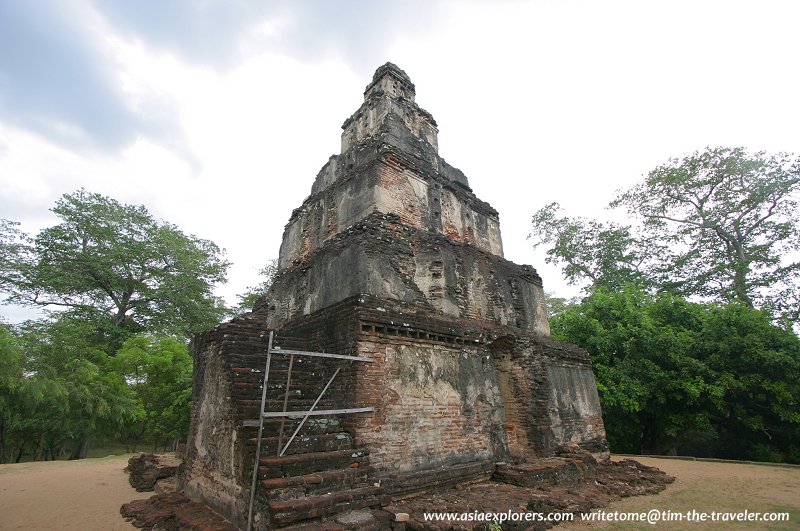 Staircase going up Satmahal Prasada (29 August, 2005)
Staircase going up Satmahal Prasada (29 August, 2005)
History of Sri Lanka
Sri Lanka has a long history that goes back to the dawn of time. The history of the Sinhala people began with the arrival of an Indian prince named Vijaya. On the island of Lanka (the ancient name for Sri Lanka), Vijaya discovered that it was already inhabited, by a people called Yaksha. He took as his wife the queen of the Yakshas. Later, Vijaya took another wife, a Pandyan princess from South India, and he also brought women from there to be wives of his followers. They were regarded as the earliest settlers of Lanka.Buddhism was introduced to Lanka in the 3rd century BC. It came about when a Buddhist missionary, Bhikkhu Mahinda, who is the brother of the Buddhist Emperor Asoka of India, arrived in Lanka, and succeeded in converting the Sinhalese King Devanampiyatissa at Mihintale.
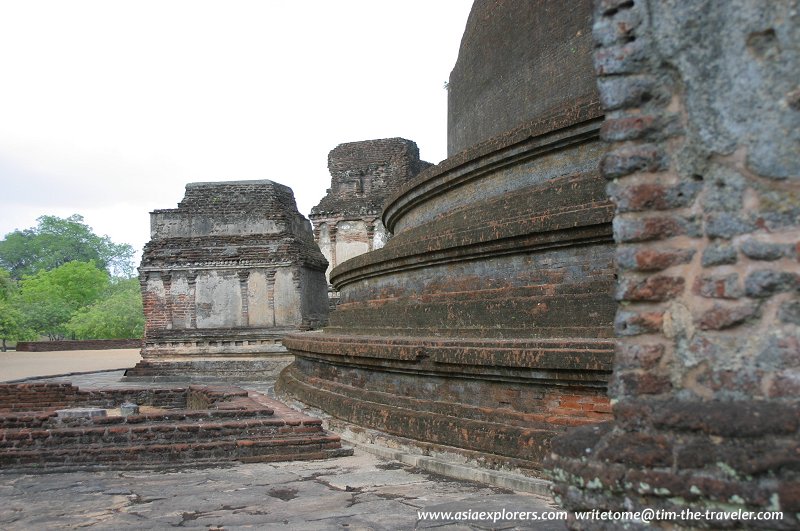 The base of Rankot Vihara (29 August, 2005)
The base of Rankot Vihara (29 August, 2005)
The first ancient capital of Lanka was the city of Anuradhapura. Next came Polonnaruwa. There were a succession of other cities that served as capital. Throughout history, there was repeated invasions by armies from South India, resulting in the shifting of the capital.
Colonial powers arrived in Sri Lanka in 1505, when the Portuguese landed. At that time there were three kingdoms on the island, namely Yarlpanam (Anglicised Jaffna) in the north, Kandy in the central hills and Kotte at the Western coast. In 1956, the Dutch defeated the Portuguese and became the second colonial power in Sri Lanka. As the Portuguese and Dutch were mainly interested in the spice trade, and so concentrated only on the coastal areas. The hilly region remained independent, allowing the Kingdom of Kandy to continue flourishing uninterrupted, until the arrival of the British.
 The Indian Ocean at Galle (2 September, 2005)
The Indian Ocean at Galle (2 September, 2005)
Great Britain replaced the Dutch in 1796 - at a time when the Netherlands were weakened by the Napoleon invasion back home. The coastal areas became a crown colony in 1802. The kingdom of Kandy fell in 1815, setting in motion the unification of the entire island under a single administration, which happened in 1818.
A struggle for independence started in the 1930s, and Sri Lanka won its independence in 1948, becoming a member of the British Commonwealth. Under British rule, it was known as Ceylon, a name that it held until 1972, when it changed its name to Sri Lanka. The name Sri Lanka, which has its origin in Sanskrit, means "venerable Lanka". Lanka is a name that has long been associated with the island since ancient times.
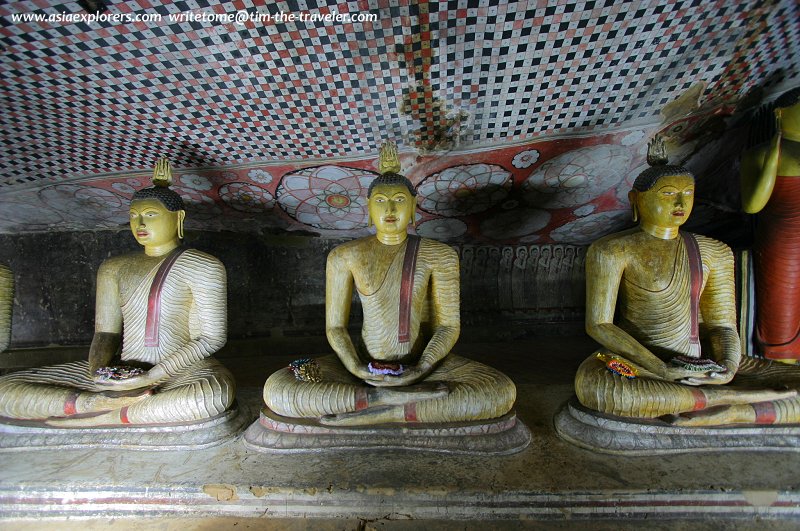 Seated Buddha statues, Dambulla Cave (30 August, 2005)
Seated Buddha statues, Dambulla Cave (30 August, 2005)

Copyright © 2003-2025 Timothy Tye. All Rights Reserved.

 Go Back
Go Back